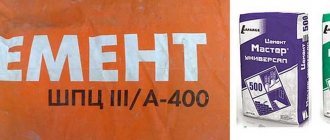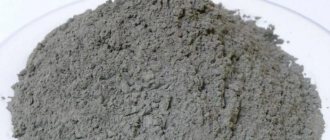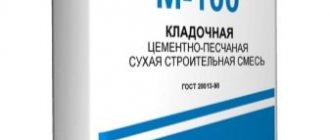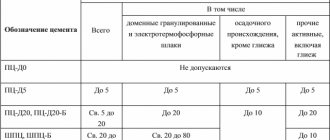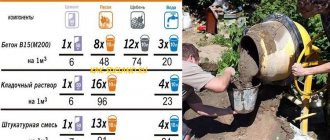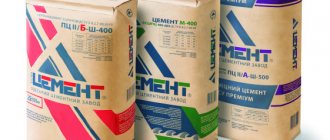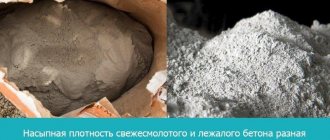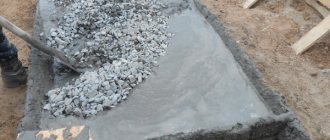Cement serves to bind mortar fillers. It is a finely ground powder that changes its chemical and physical properties upon contact with water and other liquids. In this case, a plastic mass is formed, which can be given any shape, and after it hardens, it becomes a hard stone. The properties of solutions depend on the brand of cement, so you need to know what this parameter is and how much it affects the technical and operational properties of the mixture.
Properties and characteristics of cement
Cement grades reflect the main characteristics necessary for the preparation of high-quality mortars. This material is made from clinker, which makes up the bulk of it. They are made by burning limestone and clay and then grinding them into fine powders. The smaller the fraction of the astringent inorganic component, the faster the mortar hardens. To improve the properties, mineral impurities are added - pyrites, bauxites, tripolis. The main characteristics of the material include:
- Strength is the mechanical load withstood by the sample. The sample contains 25% binder and 75% pure quartz sand. A 10x10x10 cm sample poured into a mold is destroyed to determine the pressure. Cement grades are classified according to the strength of the resulting solution.
- Setting time is the most important parameter affecting the speed of work, especially at low temperatures. To speed up the process, gypsum or other additives are added to the mixture.
- Frost resistance - the number of freezing and thawing cycles - to increase it, wood pitch or sodium abietate is added to the composition.
The use of various additives helps to obtain formulations with specified technical characteristics:
- Quick-setting composition;
- Sulfate-resistant, used in the construction of hydraulic structures;
- Expandable waterproof;
- Compositions with plasticizers for work at low temperatures;
- Facing materials, compositions for finishing premises;
- Standardized cement with specified properties.
Construction cements
To prepare working mixtures, composite low-clinker cements are used, obtained by joint grinding of Portland cement clinker, mineral active additives and various fillers to obtain the required characteristics depending on the desired purpose. Clinker is lumps of limestone and clay sintered by firing at high temperatures, ground after cooling into fine powders. The addition of mineral additives (bauxite, tripoli, pyrite) leads to improved performance characteristics, while simultaneously reducing the final cost of the material.
A typical clinker composition includes the following main phases:
- Alite (Ca3SiO5 - 3-calcium silicate), the content of this most important component of all clinkers ranges from 50 to 70 percent. Reacting relatively quickly with water, this component plays a vital role in the strength gain of cement compositions (especially on the 28th day).
- Belite (Ca2SiO4 - 2-calcium silicate), contained in normal clinkers in an amount of 15 to 30 percent. The reaction of this component with water occurs slowly, so its influence on the strength characteristics increases much later. But after about a year, when pure alite and belite are in the same conditions, their strength becomes almost the same.
- Aluminate phase (3CaAS - 3-calcium aluminate. Content - 5...10%. The rapidity of the reaction with water causes an undesirable rate of setting of the working mixture, so reagents that control this process are added for neutralization.
- Ferrite phase (4CaAFS - 4-calcium aluminoferrite). Normal clinkers contain from 5 to 15 percent. The hardening rate is high in the initial periods, but later it begins to occupy an intermediate position between the hardening of alite and belite.
- Small amounts of other components (eg alkali sulfates and calcium oxides).
What does the brand of cement mean?
Cement marking allows you to accurately characterize the composition of the material and its technical properties. Currently, marking is carried out in accordance with GOST 31108-2003. The full name of the material is indicated - Portland cement, sulfate-resistant or other cement. The following is the binding component:
- CEM I – ordinary Portland cement;
- CEM II – Portland cement with additives up to 35%;
- CEM III – Portland cement with slag up to 95%;
- CEM IV – pozzolanic composition up to 55%;
- CEM V – composite mixture.
The main additive is indicated - it can be a composite (K), slag (Sh), pozzolan (P), limestone (I), prepared fly ash (Z), microsilica (MC). Their use makes it possible to achieve water resistance, quick setting or other desired properties.
The brand itself is designated M with a numerical index, which shows the compressive strength of a particular sample according to the tests performed. For example, M200 can withstand pressure of 200 kg/cm³ or 15 MPa. The measurement results are entered into tables, which reflect not only the brand, but also a modern characteristic - strength class.
| Class | Brand | Load limit | |
| MPa | kg/cm³ | ||
| B7.5 | M100 | 7,5 | 100 |
| B15.0 | M200 | 15,0 | 200 |
| B22.5 | M300 | 22,5 | 300 |
| B32.5 | M400 | 32,5 | 400 |
| B42.5 | M500 | 42,5 | 500 |
| B52.5 | M600 | 52,5 | 600 |
To obtain special grades, raw material additives are added to them, and technologies are used that will give them the desired properties. Such materials include:
- Alumina cements. They are produced by firing aluminate slag, bauxite and limestone at a temperature of 1600 C°. After grinding, such compositions, due to the high content of calcium aluminate, react intensively with water, so they gain 90% of the specified hardness in just a day. After another two days, the specified concrete strength grade M400-M600 is achieved. This type of binder generates a lot of heat when hydrated, allowing it to be used at low temperatures.
- The addition of calcium hydroaluminate, gypsum and other components makes it possible to obtain a non-shrinking, expanding or tensile material. Such mixtures harden in water, do not change volume or expand when setting, compact or self-stress.
- Slag-alkaline cement with a high content of granulated blast furnace slag, ground into a fine powder. This adds frost resistance, resistance to corrosion, and aggressive environments to mortars. Excellent for hydraulic structures, it has an average rate of strength gain.
Modern Confusion
It cannot be said that one designation is better or more informative than the other: the old marking more accurately reflects the properties of the material, the new one – the composition. Since 2008, when the European standard began to be introduced into production, binder manufacturers began to designate containers according to two standards for the convenience of customers. To this day, there are milk markings for cement in bags, for example M400 D0, PC 400 D0 and TsEM I 42.5N. In fact, this is a designation for the same material.
Professional builders also did not come to a common opinion: the old school still bases training on the 1985 standard, giving only the basics of the new regulations. In project documentation you can also find double designations.
When choosing a binder in bags, pay attention to the markings: the bag must contain any of the following types of markings.
How to determine the brand of cement?
The grade of cement is determined using special equipment in laboratory conditions, based on the strength of the sample. To do this, a test sample is taken, three parts of purified quartz sand are added to one part of the binder to obtain a test solution.
The mixture is thoroughly mixed with the addition of water, poured into 6-10 molds measuring 10x10x10 cm. The samples are kept for 28 days, during which it hardens to 98% of the calculated hardness. After this, a sample is selected, placed under a press, and the pressure at which it breaks is measured.
Measurements are carried out on six randomly selected samples. From these, 4 samples are selected with the highest pressure required for destruction, and the average value is calculated. Based on the results, the grade and strength class of cement is determined, respectively in MPa and kg/cm³.
Determination of the brand of Portland cement
One of the main properties of Portland cement is its ability to harden when interacting with water and turn into a stone-like state, while the cement stone acquires high strength. The PC is characterized by a brand. The grade of cement is determined by the tensile strength during bending of samples of prisms measuring 40x40x160 mm and during compression of their halves, made from a cement-sand mortar of composition 1:3 (by weight) on standard Volsky sand with a water-cement ratio W/C = 0.4, while their consistency according to the spread of the cone after 30 shaking on the table should be characterized by a diameter in the range of 106...115 mm.
The beams from the solution are stored in molds above water for 24 + - 2 hours, placed in a bath with a hydraulic seal. Next, they are unmolded and stored in water at a temperature of (20 + - 2) °C for 27 days. After 28 days from the moment of manufacture, the beams are removed from the water and tested for bending strength, and the resulting halves are tested for compression. The indicator of ultimate compressive strength, achieved after 28 days of standard hardening, is calculated as the arithmetic mean of the 4 highest test results. It is called cement activity. Moreover, their samples (beams and their halves) when tested must have a bending and compressive strength not lower than the values given in the table.
The grade of cement is determined based on the activity of cement. For example, if testing of cement reveals an activity of 42 MPa, then it is classified as grade 400. Portland cements are divided into grades 400, 500, 550 and 600; The minimum values of compressive and bending strength corresponding to certain brands are given in the table.
Carrying out the test
1. To determine the consistency of the cement mortar, weigh out 1500 g of sand and 500 g of cement, pour them into a spherical bowl previously wiped with a wet cloth, and move the cement and sand with a spatula for 1 minute.
2. Make a well in the center of the dry mixture, pour 200 g of water into it (W/C = 40), let the water soak in for 0.5 minutes and stir the mixture for 1 minute.
3. Transfer the solution to a mixing bowl with a previously wiped wet cloth and mix in sequence for 2.5 minutes (20 revolutions of the mixing bowl).
4. Place the cone shape in the center of the shaking table disk. Wipe the inner surface of the cone and the table disk with a damp cloth before testing.
5. At the end of mixing, fill the cone with the solution to half its height and compact it 15 times with a metal bayonet.
6. Fill the cone with a slight excess of solution and bayonet it 10 times, after compacting the top layer, cut off the excess solution with a knife flush with the edges of the cone, then remove it in the vertical direction.
7. Shake the solution on the table 30 times, then use a caliper to measure the diameter of the cone along the lower base in two mutually perpendicular directions and take the average value. The spread of a cone with W/C = 0.40 should be in the range of 106-115 mm. If the cone spread is less than 106 mm, increase the amount of water to obtain a cone spread of 106-108 mm; if the cone spread is more than 115 mm, the amount of water is reduced to obtain a spread of 113-115 mm and compression.
8. Before making samples, lightly lubricate the inner surface of the mold walls and tray with machine oil. Coat the joints of the outer walls with each other and with the mold tray with a thin layer of grease or other lubricant.
9. Place the nozzle on the assembled mold and coat the joint between the mold and the nozzle with thick grease on the outside.
10. To compact the solution, firmly fix the shape of the beams with the nozzle in the center of the vibrating platform. Fill the mold to approximately 1 cm in height. With the solution, turn on the vibrating platform during the first 2 minutes of vibration, fill all mold cavities evenly in small portions with the solution. When 3 minutes have passed from the start of vibration, turn off the vibration platform. Remove the form from the vibrating platform, cut off the excess solution with a knife moistened with water, smooth the surface of the samples flush with the edges of the form and mark them.
11. After making samples in molds, store for 24 + - 2 hours. In a bath with hydraulic solution. After the storage time has expired, carefully disassemble the samples and place them in baths with drinking water in a horizontal position so that they do not come into contact with each other. Water should cover the samples by at least 2 cm. Change the water every 14 days.
12. After the expiration of the storage period, remove the samples from the water and no later than 30 minutes later they can be tested. Immediately before testing, the samples must be wiped dry.
13. To determine the bending strength, place the sample on the supporting elements of the device so that its horizontal edges are in a vertical position during manufacture. The bending strength is calculated as the arithmetic mean of the 2 highest test results of 3 samples.
The tensile strength is calculated using the formula:
where P -
breaking load, N or kgf.
14. The 6 halves of the beams obtained after the bending test are immediately subjected to a compression test. Place the half between the plates so that the side edges, which were attached to the walls during manufacturing, are on the planes of the plates, and the corners of the plates fit tightly to the smooth end plane of the sample. Center the sample together with the plates on the press base plate.
The tensile strength is calculated using the formula:
= Р: 25,
Where 25 —
plate area, cm2;
R -
breaking load (device readings), N or kgf.
Depending on the ultimate strength under axial compression and bending, the activity and grade of cement are determined.
Table 2—Requirements for brands of Portland cement and its varieties
| Name of cement | Cement brand | Tensile strength, MPa (kgf/cm2) | |
| when compressed | when bending | ||
| PC | M400 | 40(400) | 5,5 (55) |
| M500 | 50(500) | 6,0(60) | |
| M550 | 55(550) | 6,2(62) | |
| M600 | 60(600) | 6,5(65) | |
| BTC | M400 | 40(400) | 5,5 (55) |
| M500 | 50(500) | 6,0(60) | |
| ShPC | M300 | 30(300) | 4,5 (45) |
| M400 | 40(400) | 5,5 (55) |
15. Write the test result in the table.
Table 3—Type of cement and its characteristics
| Type of cement | V/C | Cone spread, mm | Breaking load when testing beams for bending, N | Bending strength, MPa | Breaking load when testing beam halves in compression, N | Ultimate compressive strength, MPa | Cement brand |
Control questions:
1. For what purpose is the normal density of cement paste determined?
2. What is called the beginning of setting?
3. Why are the beginning of setting and the end of setting standardized by GOST?
4. What is the activity of cement?
5. How to determine the brand of cement?
Literature:
1. Popov L.P. “Laboratory workshop” on the subject: “Building materials and parts” Moscow, Stroyizdat, 1988.
2. Kireeva Yu. I., Lazarenko O. V. "Building materials and products", Moscow, Stroyizdat, 1988.
Laboratory work No. 8
Application of different brands
The scope of application of cement depends on its brand and the characteristics that determine its properties. The main types include:
- M300 is the cheapest brand used in single-story, private construction.
- M400 – applicable for the manufacture of reinforced concrete structures, preparation of standard concrete, plaster mortars, bricklaying, concreting of above-ground and underground structures.
- M500 is used in bridge supports in water or on land, as it provides increased strength, and is used in the construction of communications and structures, and for repair work.
- M600 is intended for the production of high-quality prefabricated structures with high requirements for strength and frost resistance.
- M700 is used for concrete with strength class B35 and above, used in structures with high mechanical stress.
Various brands of Portland cement can change their properties due to additives that increase the setting speed, frost resistance, and pouring at high humidity.
The use of cement depends on its type, composition and properties:
- Portland cement – concrete monoliths, reinforced concrete structures.
- Portland slag cement – monoliths, including underground and underwater.
- Pozzolanic compositions – prefabricated structures, underwater and underground monoliths.
- Alumina - used for repairs and damage repairs due to their high setting speed. With increasing alumina concentration, the heat-resistant properties of the resulting materials increase.
- Gypsum-alumina - used for waterproof concrete, expanding and non-shrinking materials.
- Colored and white materials - used for interior and exterior finishing work.
The correct selection of cement grade will allow you to obtain a building material with the specified characteristics. The combination of mixture components, according to which the product is produced, will make it possible to produce concrete of the required strength class and hardening speed. Additional parameters provide the properties of the composition for its use in special conditions - high and low temperatures, high humidity, vibration, and other negative influences. The markings and other properties of the binder are reflected in its packaging.
Cement marking in the Russian Federation
In the Russian Federation, new cement markings compiled and applied in accordance with the requirements of the regulatory document GOST 31108-2003 “General Construction Cements”, which came into force on September 1, 2004, are considered “legal”. At the same time, in old documents and on the Internet you can find old markings of cements for general construction purposes in accordance with GOST 10178-85.
In this regard, it can be difficult for a non-specialist to figure out what building material to order for the independent construction of a building or concrete structure. Therefore, within the framework of this article, the new marking of cement GOST 31108-2003 and the old version - designation according to GOST 10178-85 will be considered.
Standard deception schemes when selling cement
If cement is delivered from a factory, then all the necessary documents are provided, and there is no risk of deceiving people. But small companies sometimes use some tricks that a naive buyer may not notice:
- Adding air to the weight of the mixture. If we are talking about a modern plant, then in this case such deception is excluded, since the cement passes through an automatic filling line equipped with scales. But small companies pack the mixtures manually and without especially weighing anything. Even if counterfeit goods are put into bags, it may well turn out that a 50 kg bag will contain only 46-48 kg. But this is not the limit; lack of sleep can amount to 10 kg.
- Inflating the brand. Again, on the production line, cement undergoes the strictest control. The mixture is evaluated, tested, and verified that it complies with GOST. Private traders can determine the brand “by eye”. Of course, in this case it will seem to the “inspector” that the brand of the mixture is higher than the real one. When buying such a composition, it is impossible to immediately tell what brand it is. It will be possible to check the quality of the mixture only after preparing and laying the batch (read about how to do this here).
Important! If you buy cement in bulk, be sure to ask a company representative for a product quality certificate.
- Use of low-quality additives. Cement must have a strict ratio of mineral additives. Its quality directly depends on the chemical and mineralogical composition of raw materials. Some unscrupulous sellers, wanting to sell cheap cement at the price of expensive ones, use mineral additives that do not have astringent properties. Because of this, the finished solution will have lower characteristics. For example, a packer can add up to 50% mineral powder, ground slag and other impurities to the mixture. Of course, such a percentage is unacceptable for many types of buildings, but again, it is very difficult to verify.
- Identical packaging. This scheme is as old as time, but is still relevant. An unscrupulous seller makes packaging in the same colors as a large manufacturer. By replacing just one letter in the name, he can count on customers who, seeing a very low price and familiar packaging, will not even bother to read the manufacturer’s name.
- Recycling of stale or expired cement. Factory cement is securely packaged in polyethylene film and durable bags. If transportation and storage are carried out in accordance with the standards, then after shipment from the plant the cement will not change its characteristics for several months. But some people store mixtures incorrectly. As a result, Portland cement cakes and turns into lumps. Such material is completely unsuitable and cannot be sold. But even here, cunning deceivers find a loophole. They crush the compacted cement and grind it. As a result, it takes on a familiar appearance, and the characteristics remain at the same low level. Therefore, a base made from such recycled material will begin to deteriorate within a few years, or even earlier.
However, it is quite possible to avoid all these troubles if you buy materials from trusted sellers (or better yet, from the factory), and also carefully study all the specified characteristics.
Useful tips
Finally, a few useful recommendations that will help identify fraudulent products:
- If you buy PCs in bulk, it is better to go directly to the factory. You should not contact intermediaries, as it is not profitable for them to work for free. This means that they are likely to sell a mixture with an increased number of additives.
- Be sure to check with the seller how the cement was stored. If he cannot answer at all or states that the mixture was stored on the street, then it is better to refuse such a purchase. The seller must know exactly how he carries out storage.
- If you buy cement in bags, then arm yourself with a steelyard (today you can find compact electronic scales up to 100 kg on sale) and be sure to check the weight of the package yourself. If it says 50 kg, but in reality it is 45, then this is clearly a product of non-factory origin.
Healthy! The weight of cement can be indicated in the format 50 +/- 1 kg.
- If you buy a large batch, then it makes sense to spend money and have the PC examined. If it turns out that the solution turned out to be of poor quality, then in the end you will have to pay much more when the concrete foundation or screed cracks.
Armed with these tips, you can protect yourself from purchasing low-quality raw materials. No matter how much the seller smiles at you and assures you that he himself has been building for 100 years using this particular PC, check everything yourself. It’s better to pay a little more and buy a high-quality composition than to overpay much more later when it turns out that the cement purchased at the mega-promotion turned out to be fake.
